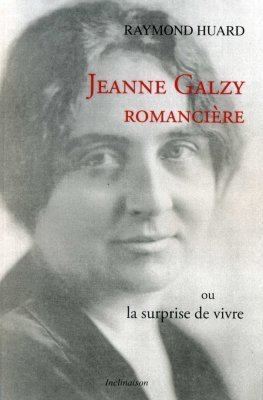Occupation novelist, biographer Nationality French Name Jeanne Galzy | Language French Notable works Les Allonges Role Novelist | |
 | ||
Genre Lesbian fiction, regional fiction, biography, drama Books Jeunes filles en serre chaude, Burnt Offering, Agrippa D'aubigne | ||
Jeanne Galzy (1883–1977), born Louise Jeanne Baraduc, was a French novelist and biographer from Montpellier. She was a longtime member of the jury for the Prix Femina. Largely forgotten today, she was known as a regional author, but also wrote three novels early in her career that explore lesbian topics; she has been referred to as one of the "pioneers in the writing of lesbian desire and despair."
Contents
Biography
Galzy was born in 1883 in Montpellier, France, the daughter of a wholesaler and an unpublished poet. She grew up in a Protestant environment and went to better schools, exceedingly rare for a young girl of the time. She studied at the Ecole normale superieure de jeunes filles in Sevres and passed the agregation competitive exam.
In 1915 she gained a position teaching at the boys' lycee in Montpellier; she was the first woman to teach at the school and replaced a man who died in the trenches of World War I. While teaching, she contracted tuberculosis, and went to convalesce in Berck. This experience led her to write Les Allonges, which received the Prix Femina in 1923. She went back to teaching, but after suffering a relapse devoted her life to writing.
After having published five novels, a play, and having received a number of literary awards, in 1929 she delivered a novel of lesbian love between a teacher and a student, L'initiatrice aux mains vides, translated in English as Burnt Offering and the winner of the 1930 Prix Brentano (which earned her $1000 and a translation of her book in English). Jeunes Filles en serre chaude (1934) aimed to be the portrait of the students of the Ecole normale superieure in Sevres; the school was reputed to be a "breeding ground of homosexual relationship," and had earlier been the subject of a novel exploring same-sex desire, Les Sevriennes (1900) by Gabrielle Reval. Galzy was a member of the jury for the Prix Femina for more than five decades.
Themes and critiques, appreciation
Galzy's novels are frequently regarded as romans a clef—transcribing her personal experiences. Thus, in La Femme chez les garcons and L'Initiatrice aux mains vides she is considered to recount her own life as a teacher in Paris, and likewise Les Allonges is supposed to treat solely her two-year disease. Galzy herself resisted such a reading (called the "autobiographical fallacy" by literary critics), claiming that writing fiction allowed her a detachment from reality. In Les Allonges, for instance, readers should find, besides a possible biographical connection, "a more general metaphysical investigation and validation of human suffering." Critics note, however, that explicit denials that a given novel is a roman a clef is often a rhetorical move; such a denial is given on the first page of Jeunes Filles en serre chaude, a novel of "intergenerational love" (between teacher and student) in a "pedagogic context" similar to Galzy's experiences at the Ecole normale superieure which questions "the suitability of contemporary educational opportunities for young women".
Three novels written relatively early in Galzy's career explore lesbian desire, L'Initiatrice aux mains vides, Les Demons de la solitude, and Jeunes Filles en serre chaude, written between 1929 and 1934. According to one critic, Galzy did not initially approach lesbianism as an issue of gender but as a problem of the social imperative against expressing same-sex attraction:
The ambiguity that interests Jeanne Galzy concerns not gender but rather her characters' process of realizing that their feelings are indeed those of love for other women. Her protagonists have no place to situate themselves socially. Heterosexuality and motherhood are the only modes of love publicly available in their world. As a result it is not surprising Galzy sidles up to the issue of lesbian desire gradually.
L'Initiatrice features a single schoolteacher who develops a relationship with a younger student. In Les Demons, a father and his daughter (who already has an intimate female friend) fall in love with the same girl. Jeunes Filles is the most explicit of the three, and again a relationship develops between a student and her teacher, in a possible love that is ultimately frustrated. Later in her career she would again return to lesbian themes in the series of novels published as La surprise de vivre (1969–1976).
In her time, Galzy enjoyed a measure of popularity and literary recognition. She was a member of the salon of Natalie Clifford Barney and was read by (and presumably influenced) writers such as Marguerite Yourcenar; Helene de Monferrand was strongly influenced by her. Galzy, like other women writers of her generation (the period between the two World Wars), has suffered from critical neglect that she "deserves to be better known today" is a common statement in many publications on her. Her work, as well as that of authors like Marguerite Audoux and Catherine Pozzi, is relatively unknown today and many of her books are no longer in print.
